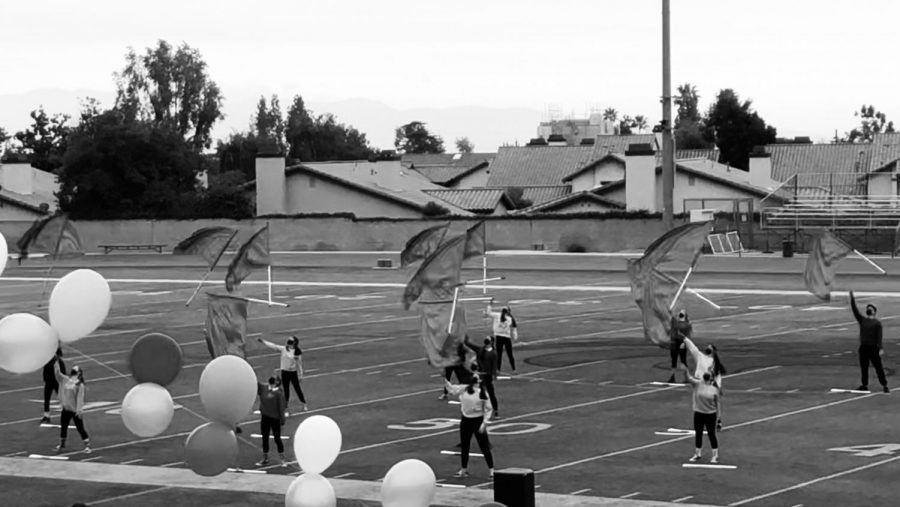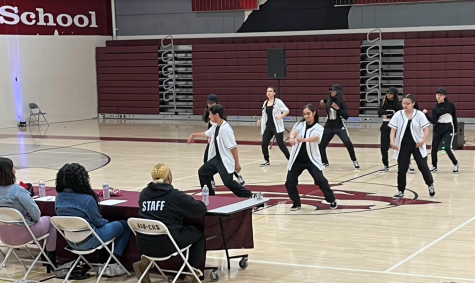Sport-Light: CHS Colorguard
Colorguard: a blend of movement and dance with silks, rifles, and sabers. During the fall season, the colorguard ensemble worked as a part of the CHS marching band, appearing and performing at band competitions as well as during the half-time show at football games. Now, colorguard is turning and preparing for their own season, the winterguard.
As the rest of the band transitions from marching band to concert band, the color guard is also shifting. Essentially, while the colorguard performs outside to music the band plays, the winterguard performs inside to recorded music. The winterguard competition season starts in February, although they prepare and practice far before that. Winterguard is the team’s opportunity to perform as one cohesive unit without having to work with the other part of the band. CHS colorguard competes against other color guard teams from across the area in the late winter and early spring.
Despite this activity looking like an extracurricular, colorguard (“the guard” for short), practices during school hours. Members choose to take marching band as their elective, and practice at the band stage. And, despite them not playing an instrument, guard members such as Freshman Abigail McClellan are a part of the marching band and firmly believe that they are underrecognized.
“I think there should be more representation,” McClellan said. “A lot of us, we’re just ‘the flags’ or ‘that flag thing you do’. And a lot of people don’t see us as part of the band, but we are. We have a band period as much as anyone else.”
All sections of the marching band have to stay in synchronization, and that is not changed later in the winterguard season. It is vital to train the muscles and sense of timing to stay in synchronization. The team achieves this by practicing constantly, every day during fifth period marching band.
Senior captain Lina Delvasto has been on colorguard for five years, staying because of her love of the team and the performance.
“We usually work on whatever show we’re working on at the moment, and there’s different kinds of equipment.” Delvasto said. “My favorite one’s saber, which is like the sword [equivalent to colorguard].”
Color guard uses three different types of equipment: the rifle, the saber, and the flag. The rifle often gets mistaken for a real rifle, although when asked, McClellan said that the rifles are just wood structures wrapped in white tape. The team practices with all three pieces of equipment during their period of 51 minutes, running through their routines for the next upcoming performance. The routines often give the guard bruised fingers, hands, or even legs. When asked about how often they hit themselves with their equipment, Delvasto and junior captain Crystal Wilcox answered with an emphatic “every single day.”
However, this does not stop the guard from having fun in their elective and creating a close relationship that Delvasto says is her favorite part of being in colorguard.
Both McClellan and Wilcox said that what they loved about colorguard was performing. The art of performance brings adrenaline, and that is what fuels these two color guard members. All color guard members interviewed believe that colorguard is a sport that more people should join.
“I think people should join [colorguard] because it’s an overall fun thing to do,” Wilcox said. “You have to be really dedicated, but it’s really worth it because the outcome of the show we produce is really, really pretty, and a lot of people really like it.”
CHS has been focused on other sports recently, but it’s time to open our eyes to all the sports in the school. Color guard members are dedicated to their elective and are rewarded with stunning performances of flags, rifles, and sabers. With all this in mind, one can only conclude that colorguard is an amazing, fun activity that is open for anyone to do in the following years.
Hello there! Our goal is to provide relavent, engaging journalism for readers of all ages. Your donation will support the student journalists of the Wolfpacket at Claremont High School, and will allow us to purchase equipment, print our monthly issues, and enter in journalism competitions. We appreciate your consideration!

Mayo Ou is the Head Editor-in-Chief of the Wolfpacket and a senior at CHS in her fourth year on the staff. Her goal this year, other than not procrastinating...










